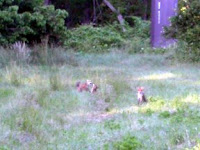Soaring with David Gessner

What better way to celebrate the 2007 centennial of Rachel Carson’s birth than a new book about ospreys, a raptor saved by the anti-pesticide outcry sparked by Silent Spring? In his acclaimed Return of the Osprey (Algonquin Books, 2001), David Gessner feted the birds’ post-DDT resurgence through reflections on a summer observing their courtship, nesting, fishing, and fledging. Intimate watching at the nest connected Gessner not only with the birds but also with their marshy Cape Cod home. Yet ironically, that book’s success helped pull the author away, to a new job as a writing professor in North Carolina. The move turned Gessner’s osprey obsession toward understanding the birds’ migratory trajectory, or, as he puts it, “My old question had been how to nest. My new question was how to be at home in movement.”
In Soaring with Fidel: An Osprey Odyssey from Cape Cod to Cuba and Beyond, Gessner follows the birds south by foot, car, boat, and computer, virtually-watching ospreys satellite-tagged for a BBC documentary. Most of his avian encounters are fleeting, though long enough for indelible descriptions of hovering, diving, and other dramatic moments. Recountings of human interactions are no less memorable, whether they depict a random couple met beside a spotting scope or hot shot birders buttoned-holed for advice. Gessner’s humor shines in these scenes, as when he imbibes beer along with lessons in soaring physics from a raptor expert near Hawk Mountain.
He switches to rum once he and the birds reach Cuba, but literary heroes accompany him all along the way. A devotee of Thoreau, Gessner here favors Whitman. A worn copy of Leaves of Grass, swiped from one of many guesthouses that shelter him, reveals a fellow wanderer who valued freedom as much as connection. Who would want just one cabin in the woods, Gessner asks, when you could experience many? “So many possible Waldens, “ says the author, “Cabin after cabin. Waldens on the fly.”
As often as he crosses geographical borders, Gessner shifts writing styles.
A lyrical passage on a mountain thunderstorm is soon succeeded by a farcical report on how broken Spanish affects testy immigration officials. This is not just a literary device or quirk but a sign of commitment to crossing boundaries of writing genres and natural place. As Rachel Carson depicted in her natural history classic, The Edge of the Sea, Gessner views borders as fertile spaces for wildlife and the imagination. In Soaring with Fidel, he richly imagines life on the wing for a magnificent raptor and reimagines a meandering but sure route toward his own happiness.













